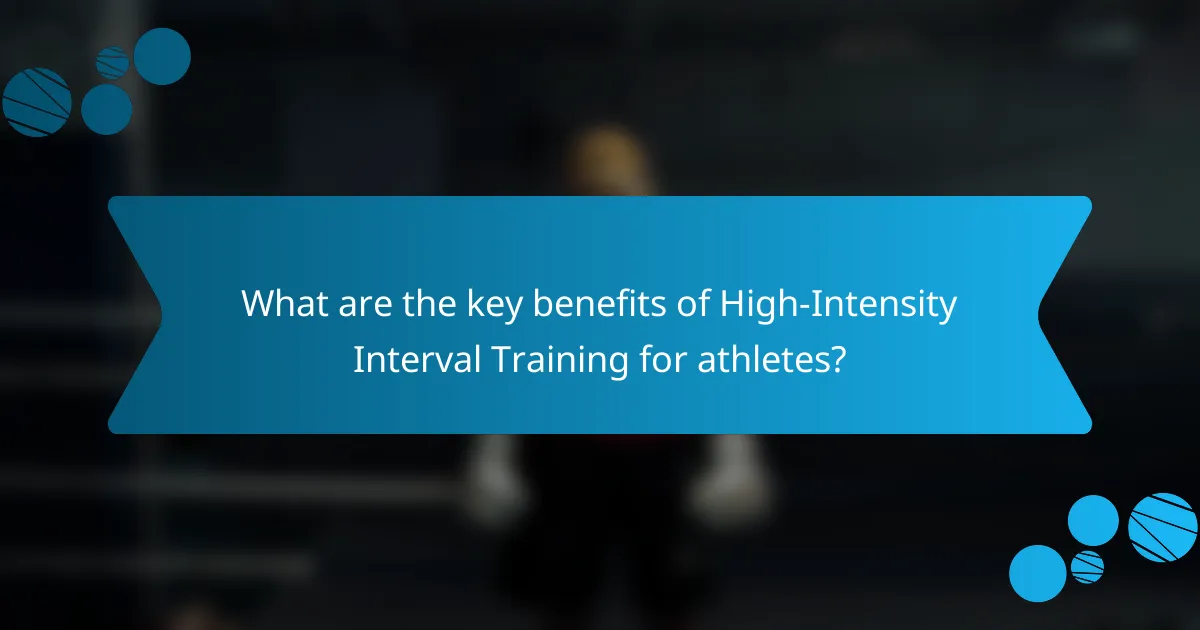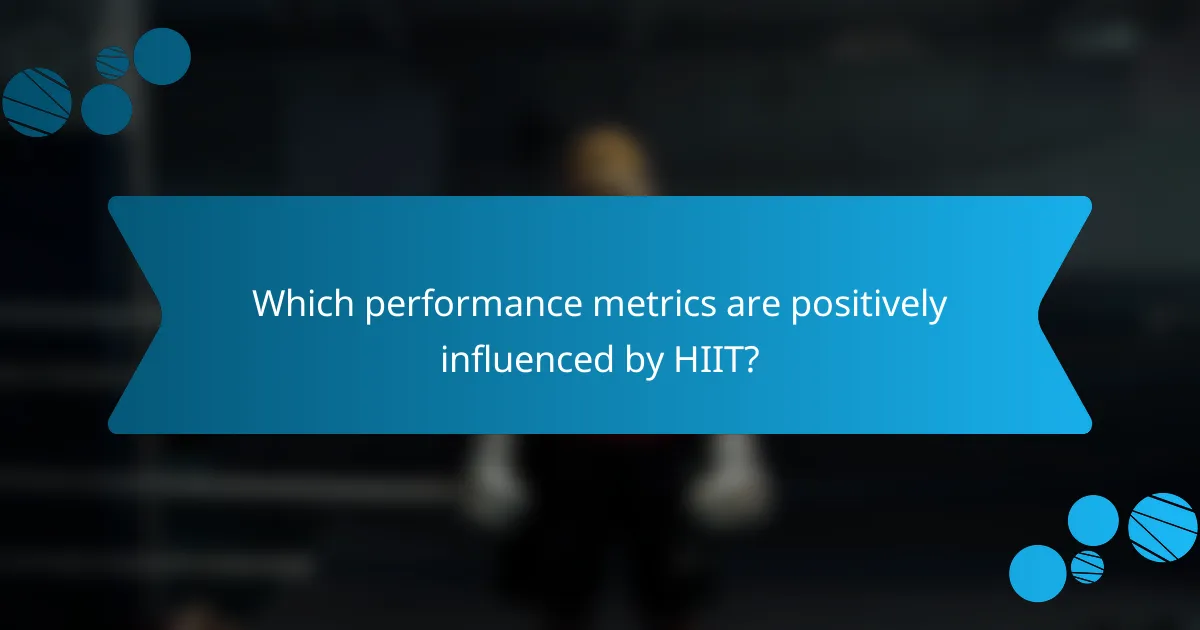High-Intensity Interval Training (HIIT) significantly enhances athletic performance by improving endurance, speed, and recovery. This method boosts cardiovascular capacity, promotes efficient fat loss, and reduces training time. HIIT protocols like Tabata and the 30-30 method can lead to substantial increases in VO2 max and lactate threshold. Athletes also develop unique adaptations that enhance their overall performance and resilience against fatigue.

What are the key benefits of High-Intensity Interval Training for athletes?
High-Intensity Interval Training (HIIT) significantly enhances athletic performance through improved endurance, speed, and recovery. This training method boosts cardiovascular capacity, allowing athletes to perform at higher intensities for extended periods.
HIIT promotes efficient fat loss while preserving muscle mass, resulting in optimal body composition. Athletes experience increased metabolic rate, benefiting overall energy levels and performance.
Additionally, HIIT can reduce training time while maximizing results, making it a practical choice for busy athletes. Incorporating varied intervals keeps workouts engaging and can prevent training plateaus.
Ultimately, HIIT fosters mental resilience, as athletes learn to push through discomfort and fatigue, enhancing their competitive edge.
How does HIIT improve cardiovascular fitness?
High-Intensity Interval Training (HIIT) significantly enhances cardiovascular fitness by increasing heart rate variability and improving oxygen uptake. This training method promotes efficient heart function and boosts overall endurance. HIIT workouts elevate the metabolic rate, leading to improved cardiovascular efficiency. Studies show that athletes engaging in HIIT experience a 20% increase in VO2 max, indicating enhanced aerobic capacity. Furthermore, HIIT’s varied intensity levels stimulate adaptations in the cardiovascular system, leading to long-term performance improvements.
What role does HIIT play in enhancing muscular endurance?
High-Intensity Interval Training (HIIT) significantly enhances muscular endurance by promoting efficient energy utilization and improving muscle recovery. HIIT involves short bursts of intense exercise followed by rest, which conditions muscles to perform under fatigue. Research shows that athletes incorporating HIIT can increase their endurance capacity by up to 30%. This training method also boosts aerobic and anaerobic performance, facilitating better overall athletic development. By pushing muscles to adapt to high-intensity efforts, HIIT optimizes performance in endurance sports.
How can HIIT contribute to faster recovery times?
High-Intensity Interval Training (HIIT) enhances recovery times by promoting efficient muscle repair and reducing inflammation. The intense bursts of activity followed by rest stimulate metabolic processes that accelerate healing. HIIT also improves cardiovascular function, which aids in nutrient delivery to muscles post-exercise. Studies show that incorporating HIIT can lead to a 30% reduction in recovery time compared to traditional training methods. This makes it a valuable strategy for athletes seeking to optimize performance and minimize downtime.
What are the psychological benefits of incorporating HIIT into training?
Incorporating High-Intensity Interval Training (HIIT) into training offers significant psychological benefits for athletes. HIIT enhances motivation and boosts self-efficacy through quick, achievable workouts. It also reduces perceived exertion, making intense sessions feel more manageable.
Athletes often experience improved mood and reduced anxiety following HIIT sessions. This is attributed to the release of endorphins, promoting a positive mental state. Furthermore, HIIT fosters a sense of community among participants, enhancing social support and accountability, which are crucial for sustained training adherence.
Overall, the psychological advantages of HIIT contribute to better performance and athlete development by creating a more enjoyable and less intimidating training environment.

Which performance metrics are positively influenced by HIIT?
High-Intensity Interval Training (HIIT) positively influences various performance metrics in athletes. Key metrics include increased aerobic capacity, improved anaerobic performance, enhanced muscular endurance, and faster recovery times. These benefits contribute to overall athletic development and performance improvement.
| Performance Metric | Description |
|—————————–|——————————————————|
| Aerobic Capacity | Increases VO2 max, enhancing endurance. |
| Anaerobic Performance | Boosts power output during high-intensity efforts. |
| Muscular Endurance | Improves ability to sustain prolonged physical activity.|
| Recovery Time | Reduces time needed to recover between intense efforts.|
How does HIIT affect speed and agility?
High-Intensity Interval Training (HIIT) enhances speed and agility by improving anaerobic capacity and muscular endurance. This training method involves short bursts of intense exercise followed by rest, which develops fast-twitch muscle fibers critical for quick movements. Studies show that athletes incorporating HIIT can increase their sprinting speed by up to 15% within weeks. Additionally, HIIT promotes better coordination and reaction times, essential for agility in sports. As a result, athletes experience improved performance in competitive settings.
What impact does HIIT have on strength gains?
HIIT significantly enhances strength gains by promoting muscle hypertrophy and improving overall athletic performance. This training method incorporates short bursts of intense exercise followed by rest, which effectively stimulates muscle fibers.
Research indicates that HIIT can lead to greater increases in strength compared to traditional endurance training. A study found that participants engaging in HIIT experienced a 20% increase in strength over eight weeks. This is attributed to the unique attribute of HIIT, which combines resistance training elements with cardiovascular conditioning.
Additionally, HIIT improves metabolic rate, allowing for increased calorie burn during and after workouts. This rare attribute enhances body composition, contributing to better strength-to-weight ratios. Overall, HIIT serves as a powerful tool for athletes aiming to boost strength and performance.
How is endurance measured before and after HIIT training?
Endurance is measured before and after HIIT training through various fitness tests and metrics. Common methods include timed runs, VO2 max tests, and lactate threshold assessments. These metrics provide insights into cardiovascular efficiency and muscular endurance. Improvements in these areas indicate effective training adaptations from HIIT.

What are the most effective HIIT protocols for athlete development?
High-Intensity Interval Training (HIIT) protocols effectively enhance athlete development and performance. These protocols, characterized by short bursts of intense exercise followed by rest or low-intensity periods, improve cardiovascular fitness, muscular endurance, and metabolic efficiency.
One effective HIIT protocol is the Tabata method, which consists of 20 seconds of all-out effort followed by 10 seconds of rest, repeated for four minutes. This method significantly boosts anaerobic capacity and overall performance. Another popular protocol is the 30-30 method, involving 30 seconds of high-intensity work followed by 30 seconds of recovery, which enhances aerobic endurance and power output.
Research indicates that implementing HIIT can lead to a 20% increase in VO2 max, a key indicator of aerobic fitness. Additionally, HIIT can improve lactate threshold, allowing athletes to perform at higher intensities for longer durations.
Incorporating varied HIIT protocols tailored to specific sports can yield optimal results. For instance, sprinters may benefit from shorter, more intense intervals, while endurance athletes might focus on longer intervals with moderate intensity.
Which HIIT formats are commonly used in professional sports?
Common HIIT formats in professional sports include Tabata, Circuit Training, Fartlek, and EMOM (Every Minute on the Minute). Each format emphasizes short bursts of high-intensity exercise followed by recovery periods, enhancing athletic performance and endurance. Tabata consists of 20 seconds of intense effort followed by 10 seconds of rest, repeated for four minutes. Circuit Training incorporates various exercises targeting different muscle groups in a sequence. Fartlek combines continuous running with intervals of sprinting, while EMOM requires athletes to complete a set number of repetitions every minute. These formats effectively improve speed, strength, and overall fitness in athletes.
How can athletes customize HIIT sessions for their specific needs?
Athletes can customize HIIT sessions by adjusting intensity, duration, and recovery intervals to meet their specific performance goals. Tailoring these variables allows athletes to focus on endurance, strength, or speed, depending on their training needs.
For example, a sprinter may opt for shorter, high-intensity intervals with longer rest periods, while a long-distance runner might incorporate longer intervals with shorter recovery times. This customization enhances overall athletic performance and development by targeting specific energy systems and muscle groups.
Additionally, athletes should consider integrating sport-specific movements into their HIIT routines. This approach not only improves functional strength but also simulates the demands of their sport, leading to better performance outcomes. Regularly assessing progress and adjusting these parameters ensures continued improvement and adaptation.
What is the optimal duration and frequency for HIIT workouts?
The optimal duration for HIIT workouts is typically 20 to 30 minutes, with sessions occurring 2 to 3 times per week. This frequency allows for significant performance improvement while minimizing the risk of overtraining. Research indicates that such a regimen can enhance cardiovascular fitness and muscular strength effectively. Athletes may benefit from incorporating recovery days to maximize the training effects and prevent fatigue.

What challenges do athletes face when implementing HIIT?
Athletes face several challenges when implementing High-Intensity Interval Training (HIIT). These include managing recovery time, ensuring proper technique, and maintaining motivation.
Recovery time is crucial. Athletes may struggle with adequate rest between sessions to prevent overtraining and injuries. Proper technique is essential to maximize benefits and minimize injury risk. Athletes often find it challenging to maintain focus during intense intervals, which can hinder performance.
Additionally, motivation can wane due to the demanding nature of HIIT. Athletes may need support systems or structured programs to stay engaged. Balancing HIIT with other training modalities also poses a challenge, as athletes must integrate it effectively into their overall training regimen.
How can athletes avoid injury during HIIT training?
Athletes can avoid injury during HIIT training by incorporating proper warm-ups, maintaining correct form, and gradually increasing intensity. Focus on recovery and listen to body signals to prevent overtraining. Proper nutrition supports muscle repair and overall performance.
What are common misconceptions about HIIT?
Common misconceptions about high-intensity interval training (HIIT) include beliefs that it is only for elite athletes and that it leads to excessive muscle loss. HIIT is beneficial for all fitness levels and can promote muscle preservation when combined with proper nutrition. Another myth is that longer workouts are always better; HIIT can yield significant results in shorter durations. Lastly, some think HIIT is solely about cardio; it can also enhance strength and power through various exercises.
How does nutrition play a role in maximizing HIIT benefits?
Nutrition significantly enhances the benefits of high-intensity interval training (HIIT) by fueling performance and recovery. Proper nutrition provides essential macronutrients, such as carbohydrates for energy and proteins for muscle repair. Athletes who consume a balanced diet rich in these nutrients can improve their endurance and strength during HIIT sessions.
Hydration is another critical aspect; adequate fluid intake prevents fatigue and maintains optimal performance levels. For example, a study found that even mild dehydration can impair athletic performance by reducing strength and stamina.
Additionally, timing of nutrient intake can optimize HIIT results. Consuming carbohydrates and proteins shortly after workouts aids recovery and muscle growth. Athletes focusing on nutrition can experience improved overall performance, reduced injury risk, and enhanced recovery times.

What unique adaptations occur in athletes who regularly practice HIIT?
Athletes who regularly practice HIIT develop unique adaptations that enhance performance and recovery. These adaptations include improved cardiovascular efficiency, increased anaerobic capacity, and enhanced muscle endurance. HIIT promotes greater mitochondrial density, allowing muscles to utilize oxygen more effectively. Additionally, athletes experience improved metabolic flexibility, enabling better fat oxidation during exercise. These factors contribute to overall athletic performance and resilience against fatigue.
How does HIIT influence metabolic rate differently across athletes?
HIIT influences metabolic rate differently across athletes based on their training status and intensity levels. Trained athletes experience a greater post-exercise oxygen consumption (EPOC) effect, leading to enhanced calorie burn post-workout. In contrast, untrained individuals may see a more modest increase in metabolic rate due to lower intensity levels. Factors such as muscle mass and aerobic capacity also play significant roles in these variations. For example, endurance athletes may sustain elevated metabolic rates longer than strength-focused athletes.
What unique physiological changes can be observed in elite athletes?
Elite athletes experience unique physiological changes from high-intensity interval training (HIIT), enhancing their performance. These changes include increased VO2 max, improved anaerobic capacity, and enhanced muscle oxidative capacity. HIIT promotes greater cardiovascular efficiency, allowing athletes to sustain higher intensities. Additionally, it stimulates muscle hypertrophy and improves metabolic flexibility, enabling better energy utilization during competition. These adaptations contribute significantly to overall athletic performance and endurance.

What are the best practices for integrating HIIT into an athlete’s training regimen?
Integrating High-Intensity Interval Training (HIIT) into an athlete’s regimen enhances performance and development. Key best practices include structured workouts, proper recovery, and tailored intensity levels.
1. Establish a clear goal for HIIT sessions, such as improving speed or endurance.
2. Begin with a warm-up to prepare the body and reduce injury risk.
3. Design intervals that alternate between high-intensity bursts and active recovery, typically ranging from 20 seconds to 2 minutes.
4. Monitor heart rate to ensure athletes are training within their target zones for optimal benefits.
5. Incorporate HIIT 2-3 times per week, allowing adequate recovery time between sessions to prevent overtraining.
6. Adjust the duration and intensity based on the athlete’s experience and fitness level.
These practices foster improved cardiovascular fitness, muscle strength, and overall athletic performance.
How can coaches effectively monitor athlete progress during HIIT?
Coaches can effectively monitor athlete progress during HIIT by utilizing performance metrics and feedback mechanisms. Regular assessments of heart rate, recovery times, and workout intensity provide insights into an athlete’s development.
Implementing technology, such as wearable devices, allows real-time data collection. This data helps in adjusting training loads and ensuring optimal performance.
Structured feedback sessions enable athletes to discuss their experiences and challenges, fostering a collaborative approach to training.
Additionally, setting specific, measurable goals enhances motivation and accountability, leading to improved outcomes in athlete performance.
What tips do experts recommend for optimizing HIIT sessions?
Experts recommend focusing on intensity, proper recovery, and varied exercises to optimize HIIT sessions. Prioritize high effort during work intervals to maximize cardiovascular and muscular benefits. Incorporate adequate rest periods to enhance performance and reduce injury risk. Vary exercises to engage different muscle groups and prevent plateauing.
What common mistakes should athletes avoid when starting HIIT?
Athletes should avoid starting HIIT without proper warm-up, neglecting form, overtraining, and skipping recovery. These mistakes can lead to injuries and hinder performance improvement.
1. Insufficient warm-up: Failing to prepare muscles increases injury risk.
2. Poor form: Incorrect technique diminishes effectiveness and raises injury chances.
3. Overtraining: Excessive intensity without rest can lead to burnout and decreased performance.
4. Inadequate recovery: Skipping rest days impairs muscle repair and growth.